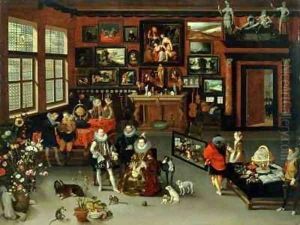H. II & Brueghel, Jan I Francken Paintings
Jan Brueghel the Elder, also known as Jan Brueghel I or 'Velvet' Brueghel, was a prominent Flemish painter and draughtsman. He was born in Brussels between 1540 and 1545 into the famous Brueghel family of artists. His father, Pieter Brueghel the Elder, was a significant artist of the Dutch Renaissance, and his brother, Pieter Brueghel the Younger, was also a painter. Jan Brueghel the Elder's work is known for its pioneering representation of landscapes and genre scenes.
Jan began his artistic education with his grandmother, Mayken Verhulst, who was herself an accomplished artist. He then went on to study under several prominent artists, including Pieter Goetkind II. In 1589, he traveled to Italy where he worked for Cardinal Federico Borromeo in Milan and was influenced by the Italian landscapes. In 1596, he returned to Antwerp, where he became a master in the city's Guild of Saint Luke and established his own workshop.
Brueghel's paintings often depicted intricate and lush landscapes, detailed still lifes, and allegorical themes. He collaborated with other artists, such as Peter Paul Rubens, with whom he worked on several pieces, combining his own detailed landscapes and still lifes with Rubens' figures. Jan Brueghel the Elder's works were highly regarded for their meticulous detail, vibrant colors, and innovative compositions.
He was not only a painter but also an art dealer and collector. His patrons included aristocrats and royals across Europe. Jan Brueghel the Elder passed away on January 13, 1610, in Antwerp. His sons, Jan Brueghel the Younger and Ambrosius Brueghel, continued the family's artistic legacy, becoming successful painters in their own right.
